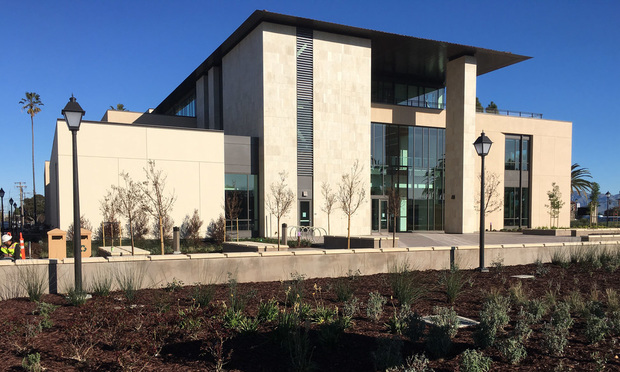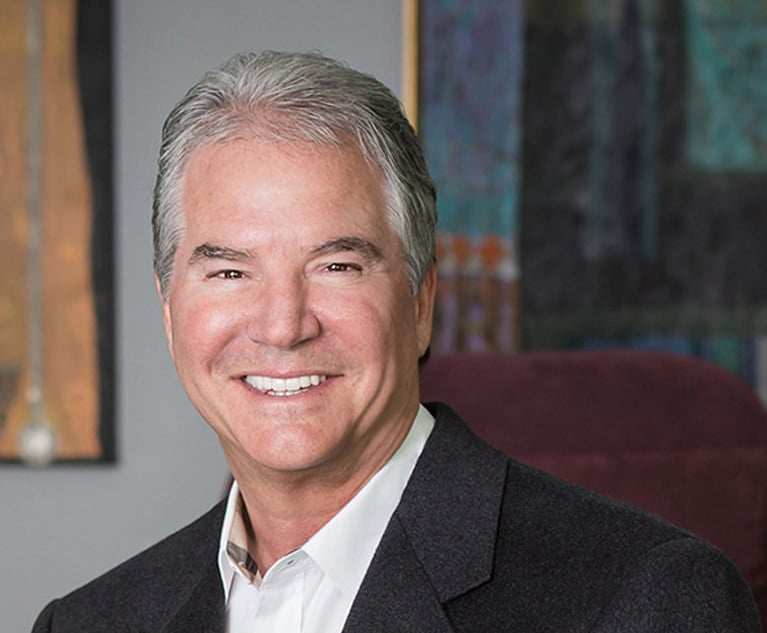Santa Clara Law's New Campus Channels Silicon Valley
Charney Hall is designed to be more comfortable for students and flexible enough to respond to the changing ways that law is taught.
March 14, 2018 at 04:44 PM
4 minute read

Faculty at the Santa Clara University School of Law are getting a major upgrade this week as they move into the school's new $60 million campus, dubbed Charney Hall.
The 96,000-square-foot building is a vast improvement over the school's existing facilities, which are spread over five different buildings, one of which was built a century ago. In contrast, Charney Hall calls to mind the nearby Silicon Valley tech campuses thanks to copious amounts of open space, natural light, cutting-edge classroom technology, plenty of student comforts, and flexible spaces that foster collaboration and innovative teaching.
Students won't start taking regular classes in the new facility until the fall, but those who have been popping in over spring break for early looks have been impressed, according to law Dean Lisa Kloppenberg. (The school plans to offer its bar review course in the new building, as well as hold several events for those on the cusp of graduation.)
“This is one comprehensive facility designed for law,” she said. “We have beautiful clinic space and we have study space throughout the building. It was designed with students as the focal point.”

The new campus boasts a first-floor coffee bar, light-filled atrium, numerous indoor and outdoor gathering places, a wellness room for nursing mothers and students with medical needs, and a meditation space that can be used by Muslim students to pray or by others looking to calm their nerves before an exam. Additionally, the building's planning committee opted against a faculty lounge, instead designing a lounge where students and faculty can dine together in hopes of fostering more interaction and mentoring opportunities, Kloppenberg said.
Planners also tried to envision how law will be taught for the next 50 years. Classrooms are wired with cameras and screens, but are also designed to accommodate different styles of teaching. One classroom, dubbed the “lawyers lab” features eight screens and flexible furniture that will allow small groups to collaborate. The school plans to use the room for conflict resolution programs as well as classes that incorporate law, business and engineering. Another room is set up to enable teleconferencing. Instead of a huge library with endless stacks of books, the library in Charney Hall is smaller, with a focus on digital materials and student study space.
Kloppenberg said she is hopeful that the new facility will help Santa Clara's recruiting, though the school has no plans to increase enrollment. (The student body and faculty have shrunk by more than a third since Kloppenberg became dean in 2013.)
“We do think this will strengthen recruiting,” she said. “It's clearly designed to welcome the law student in, and I hope it will make a big difference.”
University officials approached Kloppenberg with a proposition soon after she joined the school: They wanted to build a new center for science, technology, engineering and math (STEM) programs at the center of campus, where the law school's outdated main building now stands. In exchange for clearing out, the university would build the law school a new home, provided it raised $25 million. The university paid the remaining $35 million cost. It sounded like a great deal to Kloppenberg.
“The students will never pay a dime on it,” she said. “We will not be paying on debt servicing.”
The building is named for Santa Clara trustee and law school alumnus Howard Charney and his wife Alida, who contributed $10 million to the project. Charney is the founder of several Silicon Valley tech companies. He co-founded digital electronics manufacturer 3Com Corp., which later was sold to Hewlett-Packard Co. Charney also co-founded Grand Junction Networks, an internet connectivity company that Cisco bought in 1995.
Kloppenberg said the new building is the first step in a long-term plan to raise the law school's profile.
“We have an ambitious vision of being one of the strongest Jesuit law school in the country—kind of West Coast counterweight to Georgetown and Fordham,” she said. “That will take a while.”
This content has been archived. It is available through our partners, LexisNexis® and Bloomberg Law.
To view this content, please continue to their sites.
Not a Lexis Subscriber?
Subscribe Now
Not a Bloomberg Law Subscriber?
Subscribe Now
NOT FOR REPRINT
© 2025 ALM Global, LLC, All Rights Reserved. Request academic re-use from www.copyright.com. All other uses, submit a request to [email protected]. For more information visit Asset & Logo Licensing.
You Might Like
View All
Assessing the Second Trump Presidency’s Impact on College Sports


LSAT Administrator Sues to Block AI Tutor From Using ‘Famous, Distinctive’ Test Prep Materials
3 minute readTrending Stories
- 1We the People?
- 2New York-Based Skadden Team Joins White & Case Group in Mexico City for Citigroup Demerger
- 3No Two Wildfires Alike: Lawyers Take Different Legal Strategies in California
- 4Poop-Themed Dog Toy OK as Parody, but Still Tarnished Jack Daniel’s Brand, Court Says
- 5Meet the New President of NY's Association of Trial Court Jurists
Who Got The Work
J. Brugh Lower of Gibbons has entered an appearance for industrial equipment supplier Devco Corporation in a pending trademark infringement lawsuit. The suit, accusing the defendant of selling knock-off Graco products, was filed Dec. 18 in New Jersey District Court by Rivkin Radler on behalf of Graco Inc. and Graco Minnesota. The case, assigned to U.S. District Judge Zahid N. Quraishi, is 3:24-cv-11294, Graco Inc. et al v. Devco Corporation.
Who Got The Work
Rebecca Maller-Stein and Kent A. Yalowitz of Arnold & Porter Kaye Scholer have entered their appearances for Hanaco Venture Capital and its executives, Lior Prosor and David Frankel, in a pending securities lawsuit. The action, filed on Dec. 24 in New York Southern District Court by Zell, Aron & Co. on behalf of Goldeneye Advisors, accuses the defendants of negligently and fraudulently managing the plaintiff's $1 million investment. The case, assigned to U.S. District Judge Vernon S. Broderick, is 1:24-cv-09918, Goldeneye Advisors, LLC v. Hanaco Venture Capital, Ltd. et al.
Who Got The Work
Attorneys from A&O Shearman has stepped in as defense counsel for Toronto-Dominion Bank and other defendants in a pending securities class action. The suit, filed Dec. 11 in New York Southern District Court by Bleichmar Fonti & Auld, accuses the defendants of concealing the bank's 'pervasive' deficiencies in regards to its compliance with the Bank Secrecy Act and the quality of its anti-money laundering controls. The case, assigned to U.S. District Judge Arun Subramanian, is 1:24-cv-09445, Gonzalez v. The Toronto-Dominion Bank et al.
Who Got The Work
Crown Castle International, a Pennsylvania company providing shared communications infrastructure, has turned to Luke D. Wolf of Gordon Rees Scully Mansukhani to fend off a pending breach-of-contract lawsuit. The court action, filed Nov. 25 in Michigan Eastern District Court by Hooper Hathaway PC on behalf of The Town Residences LLC, accuses Crown Castle of failing to transfer approximately $30,000 in utility payments from T-Mobile in breach of a roof-top lease and assignment agreement. The case, assigned to U.S. District Judge Susan K. Declercq, is 2:24-cv-13131, The Town Residences LLC v. T-Mobile US, Inc. et al.
Who Got The Work
Wilfred P. Coronato and Daniel M. Schwartz of McCarter & English have stepped in as defense counsel to Electrolux Home Products Inc. in a pending product liability lawsuit. The court action, filed Nov. 26 in New York Eastern District Court by Poulos Lopiccolo PC and Nagel Rice LLP on behalf of David Stern, alleges that the defendant's refrigerators’ drawers and shelving repeatedly break and fall apart within months after purchase. The case, assigned to U.S. District Judge Joan M. Azrack, is 2:24-cv-08204, Stern v. Electrolux Home Products, Inc.
Featured Firms
Law Offices of Gary Martin Hays & Associates, P.C.
(470) 294-1674
Law Offices of Mark E. Salomone
(857) 444-6468
Smith & Hassler
(713) 739-1250







